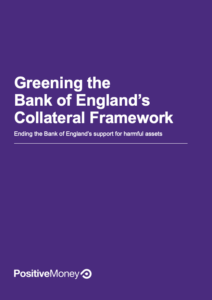Greening the Bank of England’s Collateral Framework
Published February 2024

The Bank of England’s collateral framework is a powerful tool that shapes the UK and international financial system. It specifies the assets eligible for financial institutions to use as collateral to access liquidity from the Bank, and the terms on which they can borrow. Assets that are accepted as collateral by central banks, and on more favourable terms, receive an implicit subsidy, as greater demand for such assets raises their prices and lowers yields, an impact that reverberates through the financial sector. This has significant impacts on borrowing and lending activities across the broader economy, and thus for the green transition.
This paper outlines the critical role the Bank of England’s collateral framework plays in shaping the financial system to achieve a rapid transition to a green economy. The Bank’s collateral framework is a key part of its monetary policy operations, as the means by which the Bank provides support to commercial banks and, increasingly, financial markets more widely.
PDF DOWNLOADS:
Download full report here
(Free, PDF, 35 pages)
The UK government has given the Bank’s key policy making committees a mandate to support the net zero transition, however the Bank’s progress on operationalising its green remit has stalled.
The collateral framework has an important impact on the green transition, as it shapes financial markets and the real economy. It has a significant impact on financial asset prices, composition of collateral in markets, bond yields and the availability and cost of financing for non-financial companies.
The Bank’s failure to integrate environmental risks into its collateral framework advantages environmentally harmful assets, which are able to be used by financial firms to access liquidity on more favourable terms. As a result, environmentally destructive sectors disproportionately benefit from better financing conditions than more sustainable sectors. This crucially undermines the Bank of England’s primary mandates for financial and price stability, as well as its secondary mandate to support the UK government’s economic strategy including the transition to net zero.
Policy proposals
Develop a science-based framework to assess the environmental footprints of assets and their issuers, and define the most harmful activities
Negatively screen for and exclude assets from issuers whose main economic activity is incompatible with climate and environmental goals
Introduce higher haircuts to assets based on the environmental footprint
Increase transparency over the Bank of England’s current collateral operations, including disclosing the environmental footprint of holdings